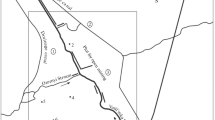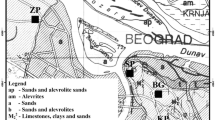The correlations between the fallout density and ratio of radionuclides in different regions of Belarus after the accident at the Chernobyl NPP are investigated using data obtained by means of gamma-spectrometric measurements performed on soil in May–July 1986. It is shown that the isotopes of cesium and/or ruthenium are most suitable for reconstructing the activity of 131I in the fallout. Charts showing the isolines of the activity ratios 131I/137Cs and 134Cs/137Cs in the fallout are constructed. The geometric averages obtained for the log-normal distribution of the ratios 134Cs/137Cs and 131I/137Cs in terms of May 10, 1986 equal 0.47 and 5.4, respectively. The distribution of the activity ratio 131I/137Cs in the fallout and the correlation coefficients show that on the whole there is no consistent interrelation between the fallout indices of these radionuclides over the territory.
Similar content being viewed by others
References
A Quarter Century after the Chernobyl Catastrophe: Results of and Prospects for Prevailing: National Report of the Republic of Belarus, Department of Cleaning Up after the Catastrophe at the Chernobyl NPP of the Ministry of Emergency Situations of the Republic of Belarus, Minsk (2011).
“Sources and effects of ionizing radiation,” in: United Nations Scientific Committee on the Effects of Atomic Radiation, V. II. Annex J: Exposures and Effects of the Chernobyl Accident, New York (2000), pp. 451–466.
B. Bennett, M. Repacholi, and Z. Carr (eds.), "Health effect of the Chernobyl accident and special health care programmes,” in: Report of the UN Chernobyl Forum Expert Group ‘Health’, Geneva (2006), pp. 1–160.
V. A. Makhon’ko and E. G. Kozlova, “Dynamics of radioiodine accumulation on soil after the accident at the Chernobyl NPP,” Radiats. Risk, No. 7, 140–191 (1996).
V. A. Pitkevich, V. V. Duba, V. K. Ivanov, et al., “Reconstruction of the composition of the Chernobyl radionuclide fallout and external radiation absorbed doses to the population in areas of Russia,” Rad. Prot. Dos., 64, 69–92 (1996).
M. G. Germenchuk, O. M. Zhukova, E. D. Shagalova, et al., “Reconstruction of radioactive contamination of the territory of Belarus by iodine-131 after the accident at the Chernobyl NPP,” Proc. Int. Semin. Conversion of Research in Belarus as Part of the Work of MNTTs, Minsk (1999), pp. 320–323.
Yu. A. Izrael, S. M. Vakulovskii, V. A. Vetrov, et al., Chernobyl: Radioactive Contamination of the Environment, Gidrometeoizdat, Moscow (1990).
Yu. P. Buzulukov and Yu. L. Dobrynin, “Release of radionuclides during the Chernobyl accident,” in: The Chernobyl Paper. Doses to the Soviet Population and the Early Health Effects Studies, Research Enterprises Inc., Richland (1993), Vol. 1, pp. 3–22.
Yu. V. Sivintsev and A. A. Khrulev, “Evaluation of the radioactive discharge during the 1986 accident in the No. 4 unit of the Chernobyl NPP,” At. Énerg., 78, No. 6, 403–416 (1995).
A. P. Ermilov and A. M. Ziborov, “Radionuclide ratios in the fuel component of radioactive fallout in the near-zone the Chernobyl NPP,” Radiats. Risk, No. 3, 134–138 (1993).
O. M. Zhukova, M. G. Germenchuk, M. A. Podgaiskaya et al., “Reconstruction of the iodine-131 fallout after the accident at the Chernobyl NPP on the territory of Gomel and Mogilev Oblasts in Belarus,” Prirod. Resursy, No. 2, 113–120 (2011).
A. Khrutchinsky, S. Kutsen, V. Drozdovitch, et al., “Mathematical modeling of a survey-meter used to measure radioactivity in human thyroids: Monte Carlo calculations of the device response and uncertainties,” App. Rad. Isot., 70, 743–751 (2012).
MCNP: A General Monte Carlo N-Particle Transport Code, Ver. 4b, LA-12625-M, Los Alamos (1997).
A. P. Ermilov and A. M. Ziborov, “Radionuclide characteristics of the fuel component of the Chernobyl radioactive fallout,” Radiats. Risk, No. 9, 95–106 (1997).
M. Yu. Orlov, V. P. Snykov, Yu. A. Kvalenskii, and A. A. Volokitin, “Soil contamination in the European part of the territory of the USSR by 131I after the accident at the Chernobyl NPP,” At. Énerg., 80, No. 6, 466–471 (1996).
The Human Health Consequences of Irradiation as a Result of the Chernobyl Accident: 2008 UNSCEAR Report to the General Assembly, Sci. App. D, UN, New York (2012).
Author information
Authors and Affiliations
Additional information
Translated from Atomnaya Énergiya, Vol. 117, No. 2, pp. 113–118, August, 2014.
Rights and permissions
About this article
Cite this article
Khrushchinskii, A.A., Kuten’, S.A., Minenko, V.F. et al. Radionuclide Ratios in Precipitation on the Territory of Belarus After the Chernobyl Accident: Calculation from Gamma-Spectrometric Measurements on Soil in May–July 1986. At Energy 117, 143–148 (2014). https://doi.org/10.1007/s10512-014-9902-4
Received:
Published:
Issue Date:
DOI: https://doi.org/10.1007/s10512-014-9902-4




